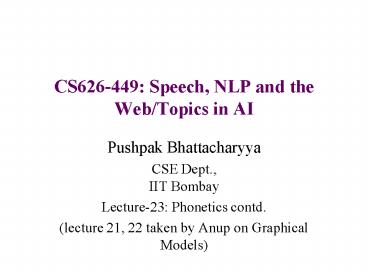CS626-449: Speech, NLP and the Web/Topics in AI - PowerPoint PPT Presentation
Title:
CS626-449: Speech, NLP and the Web/Topics in AI
Description:
Lecture-23: Phonetics contd. (lecture 21, 22 taken by Anup ... Not every sound-representing writing system represents segments (Japanese hiragana and katakana) ... – PowerPoint PPT presentation
Number of Views:27
Avg rating:3.0/5.0
Title: CS626-449: Speech, NLP and the Web/Topics in AI
1
CS626-449 Speech, NLP and the Web/Topics in AI
- Pushpak Bhattacharyya
- CSE Dept., IIT Bombay
- Lecture-23 Phonetics contd.
- (lecture 21, 22 taken by Anup on Graphical Models)
2
Phonteic Symbols and IPA notation
3
IPA vowels
4
Need for Phonetic Transcription
- Not every language has a writing system
- Not every writing system represents sounds
(Chinese characters) - Not every sound-representing writing system
represents segments (Japanese hiragana and
katakana) - The representation of speech sounds in
segment-representing writing systems is
problematic because it is highly inconsistent
(English)
5
Sound to Symbol relationship is arbitrary
- One letter, one sound b represents b in ball,
breathe, cab - A set of letters, one sound architect, shampoo,
teeth, though, cheese, enough - One letter, many sounds a represents æ in cat,
ej in cave, ? in car, ? in alike - One sound, many letters i represented
differently in sea, see, he, key, believe,
receive, people, machine - One letter, no sound knight (cf. night) , write
(cf. right, rite), comb
6
Vocal Organs
7
(No Transcript)
8
Classification
- Manner of articulation
- Place of articulation
- Voicedness
9
The sound producing system
- Lungs the source of air
- Larynx the source of noise/sound
- Vocal cords/folds
- Glottis
- Vocal tract the source of resonance/ the filters
- Pharynx
- Oral cavity
- Nasal cavity
10
Articulation of consonants Larynx action/glottis
state
- Vocal cords are pulled apart. The air passes
freely through the glottis. This is called the
voicelessness state and sounds produced with this
configuration of the vocal cords are called
voiceless p t k f ? s ? t? - Vocal cords are pulled close together. The air
passing through the glottis causes the vocal
cords to vibrate. This is called the voicing
state and sounds produced with this configuration
of the vocal cords are called voiced b d g v ð z
? d? - Vocal cords are apart at the back and pulled
together at the front. This is called the whisper
state. - Vocal cords assume the voicing state but are
relaxed. This is called the murmur state.
11
Place of Articulation (1/2)
- Labial closure or near-closure of the lips
- bilabial p b m
- labiodental f v
- Dental tip of the tongue against upper teeth or
between them - interdental ? ð
- Alveolar tongue against or near alveolar ridge
- t d s z n l r
- Alveopalatal body of tongue on or near area
behind alveolar ridge - ? ? t? d?
- Palatal body of the tongue on or near the palate
- j
12
Place of articulation (2/2)
- velar back of the tongue touching or near the
velum - k g ?
- Uvular tongue touching or near the uvula
- Pharyngeal retraction of the tongue or
constriction of pharynx - glottal vocal folds as primary articulation h ?































